(Upload on March 19 2024) [ 日本語 | English ]
Mount Usu / Sarobetsu post-mined peatland
From left: Crater basin in 1986 and 2006. Cottongrass / Daylily
HOME > Lecture catalog / Research summary > Glossary > Biology > Genetics
The study of genes, genetic variation, and heredity in living organisms
Gene system
|
|
|
[ Mendel ] Mendelian rules or laws (メンデルの法則)Law of segregation of genes (the first law)Law of independent assortment (the second law)Law of dominance (the third law)Blood type (group) (血液型)Classification
protein blood group antigen: Rh, MN, etc. 1901 ABO: Landsteiner, Karl (1868-1943, Austlia) 1927 MNS: Landsteiner, Levine, Philip (1900-1987, USA)
1932 S, Se or secretor: Schiff F, Sasaki (佐々木計) 1946 Lutheran: Callender, Race 1946 Kell: Coombs, Mourant and Race 1946 Lewis = (1946 Lea: Mourant + 1948 Leb: Andersen) 1950 Duffy: Cutbush, Mollison and Parkin 1952 Kidd: Allen, Diamond, Niedziela ABO blood type system (ABO式血液型) Classification based on the presence and absence of antibodies and inherited antigenic substances on the surface of red blood cells (RBCs)
three genes (A, B and O) on an allele = multiple alleles A, B and C (that is O in the present) 1902 von DeCastello and Sturli: discovered the present AB1907 Ottenberg, Reuben (1882-1959, USA) blood typing in transfusion (輸血) 1907 Janský, Jan (1873-1921, Czech)classified I, II, III and IV (corresponding to O, A, B and AB) 1909 Moss, William L. (1876-1957, USA)classified I, II, III and IV (corresponding to AB, A, B and O), indepdendent of Janský ⇒ made confusion |
1910 von Dungern, Emil & Hirszfeld, Ludwik
agglutinogen (antigen) = A and B → antibody = α and β
Predicted AB type is more than the measured AB type on chromosome #4 1927-28 Landsteiner et al.: discovered MN blood typecombination of antigens M and N → MM, NN and MN types Mendelian inheritance without dominance - parentage testing
1947 Walsh & Montgomery: discovered S antigen more than 40 antigen types: major elements = D, C, c, E and e
on Chromosome #1 (with Duffy) Animal blood typesABO blood type: human, gorilla, orangutan, chimpanzee and baboon Primates
chimpanzee: A and O dog: not present ABO blood type cat: A, B and AB (not equivalent to human ABO blood type) bird: not present ABO blood type amphibian and reptile: A, B and AB fish: A |
[ reproduction ]
Chromosome cytology (染色体細胞学)Keywords: karyotype, telocentric/metacentric, univalents (divalens, multivalents), chiasmata, (stages of miosis) diakinesis (metaphase I (MI) metaphase II (MII))TechniquesChromosome counts (squash technique vs thin sections), stains, pre-treatments, karyotype analysis (giemsa staining, metaphase plate)Genetics of polyploidsTetrasomic ratiosDuplicate loci Diploi Diploidization Fertility/sterility Hormonal regulation of gonadal functions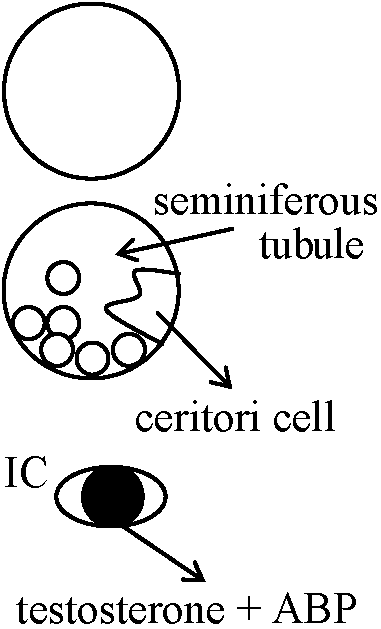 ┏━>_hypothalamus
┏━>_hypothalamus┃____↓ ┃____releasing hormones ┃____↓ ┃____anterior pituitary (AP, 下垂体前葉) ┃___ ┣━━━━━━┓ ┃____LH__________FSH ┃____↓____________↓ ┃____interstitial cells_androgen-binding protein ┃____↓____________↓ ┃____blood________spermatogenesis ┗━━┛negative feedback ♂__hypothalamus 視床下部
anterior pituitary 脳下垂体前葉 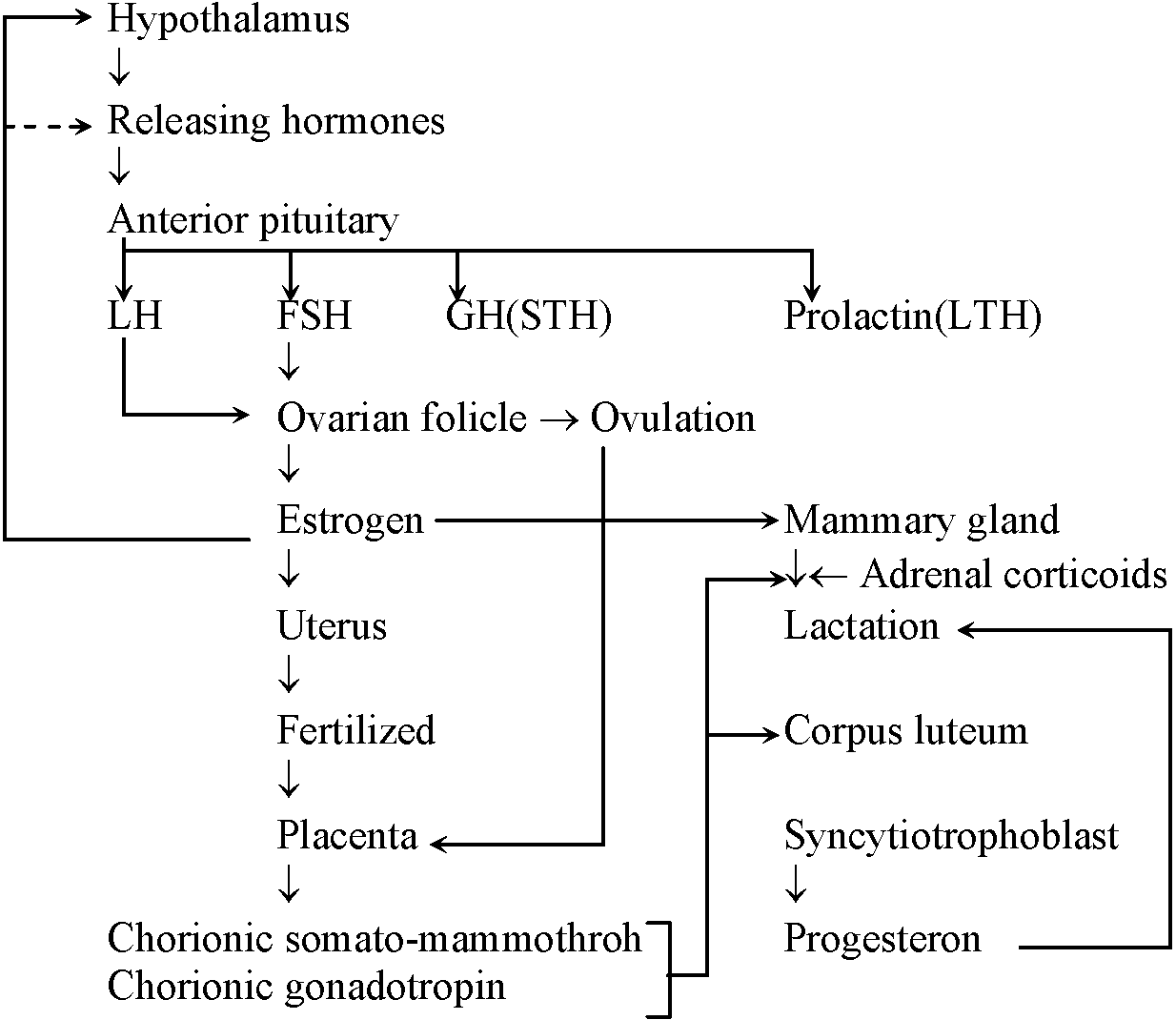 
mammary gland 乳腺 many feedbacks Releasing hormonesFSH/LH-RH: Glx-His-Trp-Ser-Tyr-Gly-Leu-Arg-Pro-Gly (pig, sheep)
TSH (thyroid-stimulating hormone) 甲状腺刺激ホルモン
Differentiation of hormones: differentiating from common base genes, infering from the resembled structures
GH (growth hormone) 成長ホルモン
α-chain β-chain
CG 92 139
LH 89 113
FSH - 115
α-chains are roughly common between the hormons but β-chains are different Dimorphism (二型性)Sex determinationDifferences in the differentiation of genital glands among species
Human egg Development of gonads (生殖腺発達)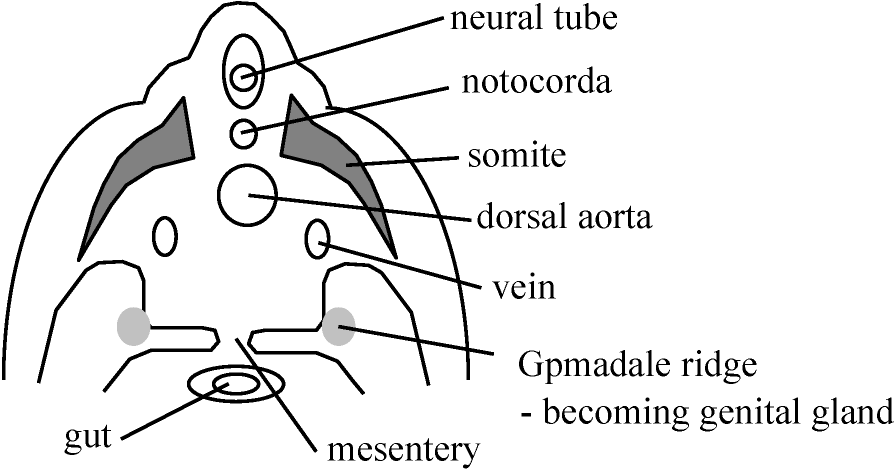 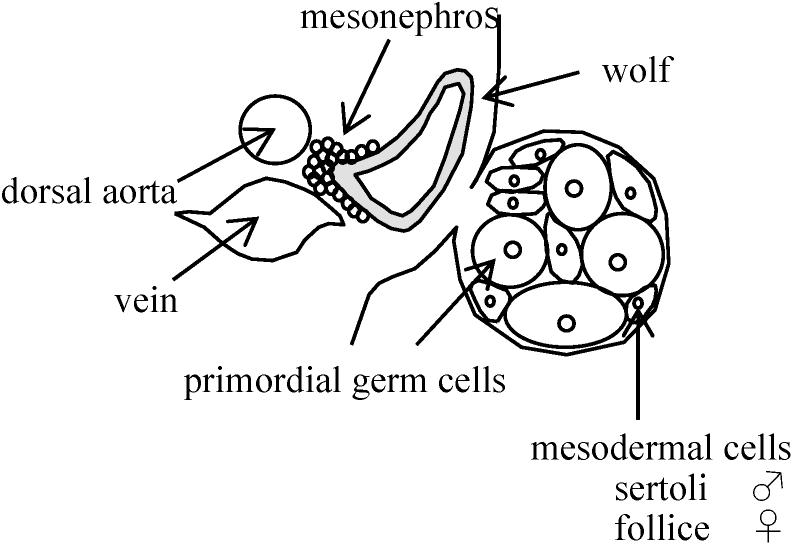 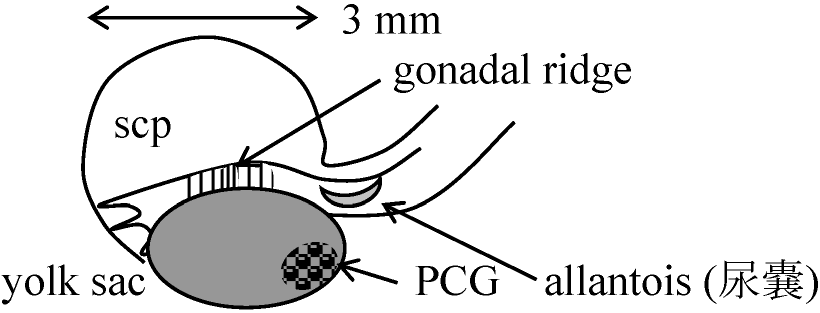 Emergence of PCG (PCGの発生)Egg: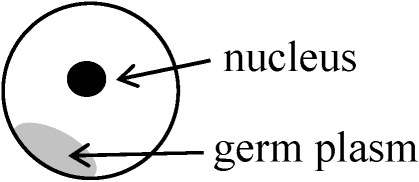
germ plasm: cells gotten germ plasm gather and produce PCG 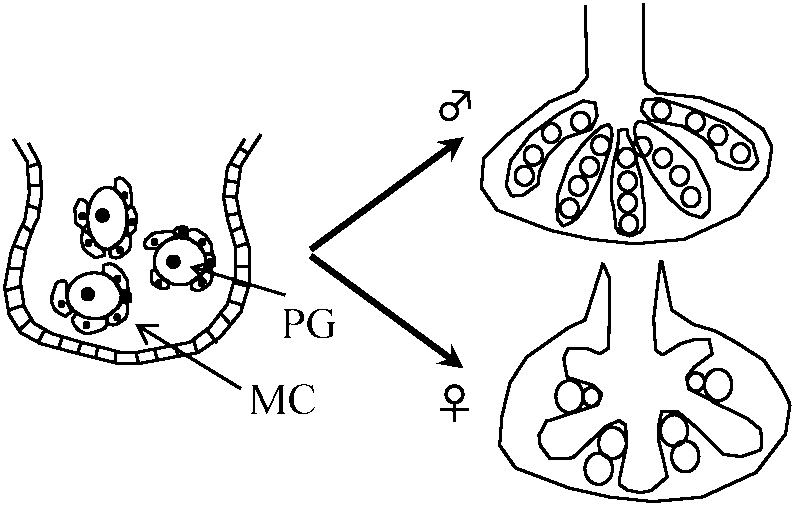  |
Development of gonads (nephros: 腎臓の前駆体)
♂ ♀
19th Primordian germ cells
migration
25-30th Wolffian duct
appears (形成開始)
37-45th gonadal ridge develops
44-48th Müllerian duct appears
50th urogenital sinus appears
60th W.M.V. complete
♀ ♂
43-50 testicular cords appear
60 sertoli cells appear
degeneration of M. begins
65 intestitial cells apper
60-75 formation of vagina 60-75 growth of W
commences fusion labio-scorotal
swelling
75 degenation of W 78 M-degeneration completes
germ cells enter to meiosis
105 prepuce formation 105 prepuce formation
ovary development commences
120 uterus completes
160-260 formation of vagina - growth of external
completes genitalia
Universal sex determination mechanism (性決定機構)consider XY type only1) Myopus 1966 Frank: mouse
♀ → ♂, ♀
26 ♂ → XY (somatic reproduction) ↓
XX XX YY death
Normal ♂XY ♀XX ♀XY
66 224 203
Abnormal ♂XXY ♀XO ♀XYY ♀XY/XYY
3 4 1 1
♀XX × XXY♂, XXY♂, XX/XXY/XXXY♂: all testes have no sperm (no ability of reproduction)
♂XY × XO♀ XO♀ XYY♀ XY/XYY♀
F1 ♂:♀ = 1/3 0/6 0/6 0/10
⇒ present gene that cancels out the effect of Y and develops ♀ of which sex chromosome is XY? Cattanach translocation
Male parent: both somatic and germ cells are normal
Estimate: ⇔ XTO = ♂, XTX = ♂ Single active theory proposed by Russel:only one chromosome has the activity ⇒ each cell has differently-active X
X-chromosome is also mosaically active mammal: number of Y choromosomes more or equal to 1 tends to becomes male (male or Y has the priority of sex determination) Q. What factors determine the sex of individuals if the sex chromosomes do not determine the sex?CCXY(♂) × XTaXTa(♀) Ta (tabby): hair with a grey or tawny coat mottled with black like a horse, not like a rabbit
→ XTaY(♂)__XTaX(♂)__XTaXTa(Ta-var♀) SXR: sex-reversalPair XTaX(♀) XY(♂) XTaX(♂) ♀:♂ X'X/XYTa-var. Normal Ta-var. SXR XTaY(♂) × XX(♂) 15 9 61(n) 124 52 1:3 1:1 6 68 58 0 1:1 1:1 XY(♂) × XTaXTa(♀) 15 9 29 40 19 1:3 1:1 6 114 116 0 1:1 1:1 ♂:♀ should be 1:1 in nature Phylogenetically SXR does not exist in ♀
XTaY(♂) AASXr × XX(♀) AA
AASxrXO → ♀
sex is determined not only by sex chromosome but also by A. SXR is discovered from various species Self or non-self recognition (自己と非自己の認識) |
|
1903, 04, 09 Rosenberg D: irregularity of chromosome distribution during meiosis on hybrids
Drosera obovata (2n = 30): observed the meiosis →
P: 2n = 14 × 2n = 14 → P: AA × BB n = 7 = A, n = 7 = B (different strains) → F1: AB [AB(♂) × AB(♀)] → F2: AABB 1919-24 Kihara (木原 均): chromosome complement and genomegenome: a minimum set of genes that are required for life → genome analysis (Triticum → x = 7 is the standard) → chromosome hypothesis on the mechanisms of heredityto demonstrate this, a few complemental discoveries are obtained Sex-controlled inheritance and mechanisms on sex determinants→ discovered sex chromosome 1902 Maclung: Conocephalus melaenusheteromorphic pair of chromosomes (不等対染色体) = affecting sex determination → Def. of sex chromosomes by Wilson: X-and Y-chromosomes1905 Wilson: stink bug, X-chromosome ♂ = 1X, ♀ = 2X The discovery of sex chromosomes were later in plants than in animals 1923 Kihara & Ono
Rumex acetosa ♂ 2n = 12 + XX, ♀ 2n = 12 + XY1Y2
aploid (anorthoploid): formed n = 13 (12 + 1) → x = 6 → forming 6 series of aploids
sex abnormality induced by cutting chromosome with different lengths → applying to gene maps on chromosoems 1924 Allen CF: Sphaerocarpos acetosa (moss)
haplont (半数体) during the gametophyte generation Structural changes in chromosomes (染色体の構造変化)Unsplit chromosomes
chromosome break
inter-arm inversion asymmetrical intrachanges
inter-arm deletion
symmetrical interchange x
unbroken
chromatid break x
unbroken Genome (ゲノム)A complete set of DNA in the individual, including all of its genesEach genome contains all of the information needed to build and maintain that individual = coding DNA + noncoding DNA + mitochondrial DNA + chloroplast DNA |
Polyploid (倍数体)1916 Winkler H 1916Neopolyploid (新倍数体)any newly-formed polyploid →neopolyploidy: the condition of being a neopolyploid Euploidy (真数性)The condition of a cell, tissue, or organism that has one or more multiples of a chromosome set, diploid (2n), triploid (3n), tetraloid (4n), pentaloid (5n), hexaloid (6n)… Euploids with more than two sets of chromosomes are POLYPLOIDS.Minimum: 2n = 4 (we have known) Heteroploidy (異型倍数性) Ex. Chromosome numbers in ArtemisiaHaploidy (倍数性):
diploid (2倍体): having twice the basic (haploid) number of chromosomes Aneuploidy (inclucing monosomics and trisomics, s.l.) (異数性)A condition in which more or less than a complete set of chromosomes is found in each cell of individual. Typically, aneuploids have one extra or one missing chromosome → Trisomic, TetrasomicAutopolyploid (autoploidy, 同質倍数体)Ex. AA × BB → AB → AABB (autoploidy, 倍化)Autotetraploid (同質4倍体)
Normal meiosis Abnormal meiosis
Parents AA × AA AA × AA AA × AA
Gametes A--+-A AA--+-A AA--+-AA
Progeny AA AAA AAAA
Normal diploid Autotriploid Autotetraploid
(fertile) (sterile) (fertile)
Allopolyploid (alloploidy, 異質倍数体)(aka, allopolyploidy, amphidiploidy, amaphiploidy)Allotetraploid (異質4倍体)
AA BB Delayed
diploidy
Step 1 AB + (unreduced gamete) AA BB
AA ABB (triploidy) AAAA BBBB
= restoration nuculei
A ABB AA BB
Step 2 + AABB cf. Segmented AABB +
alloploidy
Segmental vs genomic alloploidy Paring: auto – frequent, allo – rare β-chromosomes (= accessory chromosome or supernumery chromosome)
not belonging to neither autosome (A) or sex chromosome (X, Y) Polyploids in plants
Plant species: 30-35% (percentages of polyploidy)
somatic – often Haploid (半数体)with a single basic set of chromosomes characterizing the species→ formation of haploid by pollen culture - effective to breed improvement and gene development Terms: adelophycean (adj.): referring to the inconspicuous phase in the life history of an alga, alternating with the macroscopic (delophycean) phase Superiority of polyploid (倍数体の優位性)Caryotype analysis of Trillium chromosomes - non-homologous
Haplotype (ハプロタイプ)Haplotype network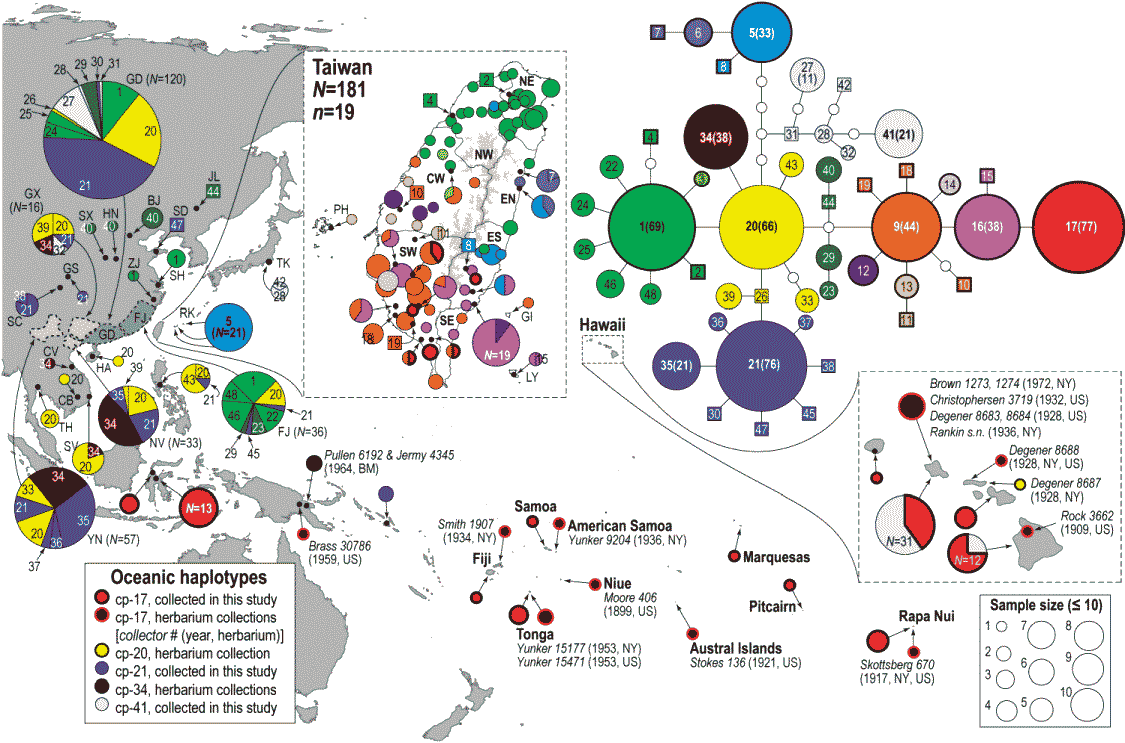 Fig. 1. Distribution of ndhF-rpl32 haplotypes and haplotype network. The sizes of the circles and pie charts are proportional to the number of individuals sampled (N) for both distribution maps and haplotype network. In the haplotype network, numbered and colored circles represent shared haplotypes and squares denote unique haplotypes. Thicker lined circles and squares (cp-1 to cp-19) are haplotypes found in Taiwan. The distributions of haplotypes in Taiwan (and its offshore islands) and the Hawaii islands are shown in enlarged maps. The map of Taiwan is demarcated by the seven major climatic regions of the island (36), with areas above 2,000 m shown in gray. (Chang et al. 2015) |
[ evolution ]
|
Three researchers contributed population genetics greatly
Fisher, Halane and Wright Fisher, Ronald Aylmer (1890-1962)mathematics, statistics, biology, genetics and academic used mathematics to combine Mendelian genetics and Darwinian natural selection 1915 the evolution of sexual preferencesexual selection and mate choice 1930 the genetical theory of natural selectiona core work of the neo-Darwinian modern evolutionary synthesis 1930 (Fisher's) Foundamental theorem of natural selection (in the book)The rate of increase in fitness of any organism at any time is equal to its genetic variance in fitness at that time increase in fitness = genetic variance Haldane, John Burdon Sanderson (1892-1964)physiology, genetics, evolutionary biology and mathematics 1924 in Russian (1936 in English) Oparin, Alexander the primordial soup theory (= Oparin–Haldane hypothesis) 1924-1934: a series of "A mathematical theory of natural and artificial selection"
quantitative analysis, e.g., selection coefficient (淘汰係数), k Wright, Sewall (1889-1988) geneticist and evolutionary biology
evolutionary theory and path analysis (path coefficient) -
1. Genetic drift (in a sub-divided population) |
1950s' controversy on the significance of genetic drift
discussed by Wright vs Fisher Muller, Hermann Joseph (1890-1967)1950 "Our load of mutations" emphasized the significance of mutation for various genetic diseases Calculation of allele frequency from genotype frequencyModel of two alleles (A, a)
AA Aa aa A. Set a, b and o are the frequencies of genes A, B and O ⇒
Mating table
A: a2 + 2ao = 0.4 ∴ a = (–1.095 ± √(1.0952 – 4·1·(-0.4)))/(2·1) ≈ 0.289 (and -1.384) … (2) (2) … 2ab = 2·0.289·b = 0.1 ∴ b ≈ 0.173 Law Hardy–Weinberg law, theorem, principle or equilibrium (ハーディ・ワインベルグの法則) Hardy, Godfrey Harold (1877-1947, mathematician, England) Weinberg, Wilhelm (1862-1937, medical scientist, Germany) find out this law separately |
Industrial melanism (工業暗化)1896 Tutt, James William: predator avoidance hypothesis
Biston betularia: carbonaria form = dark. insularia form = white less than 1% before the revolution the dark colos is camouflage from predators 1964 Ford: summarized industrial melanism |